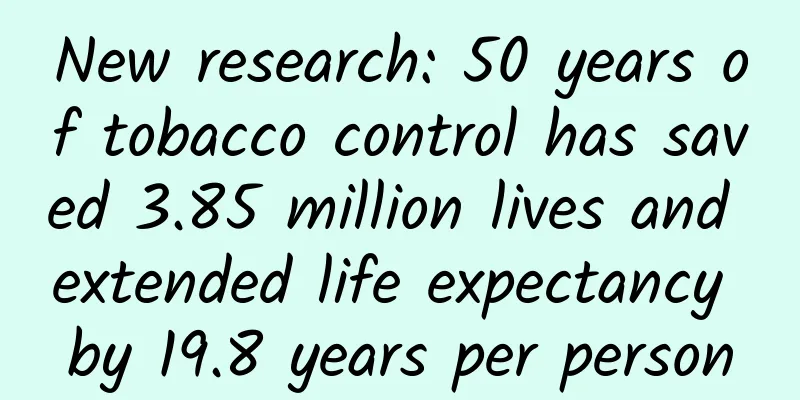New research: 50 years of tobacco control has saved 3.85 million lives and extended life expectancy by 19.8 years per person

|
Recently, a major study published in the Journal of Clinicians' Cancer showed that between 1970 and 2022, the United States' tobacco control policies successfully avoided 3.85 million lung cancer deaths and extended the life expectancy of the people by more than 76 million person-years. This study, conducted by the American Cancer Society, proved the great value of tobacco control measures with real data. Shocking data results By comparing the actual number of deaths with the expected number of deaths, researchers found that the tobacco control efforts over the past half century have brought amazing health benefits. On average, each death case avoided is equivalent to an extension of 19.8 years of life, with women benefiting more, reaching 22.4 years, and men 17.9 years. These saved lives accounted for 51.4% of the total decline in cancer deaths in the United States during the same period, highlighting the central role of tobacco control in the fight against cancer. This achievement is directly reflected in the change in lung cancer mortality. The lung cancer mortality rate for American men has dropped by 61% since its peak in 1990, and for women has dropped by 38% since its peak in 2002. This improvement is inseparable from the continued decline in smoking rates. Data show that the smoking rate for American men has dropped from 51.2% in 1964 to 13.2% in 2022, and for women from 33.7% to 10%. Although the overall results are significant, the benefits to different groups are not balanced. Studies have found that the smoking rate and lung cancer mortality risk of people with a high school education or below are more than four times that of those with a college education. This difference reveals the socioeconomic gradient challenge facing tobacco control work - the more disadvantaged the group, the more serious the smoking problem, but the more limited the ability to obtain smoking cessation resources. Effective tobacco control strategies The study found that among various tobacco control measures, raising tobacco consumption taxes is the most effective means. Price increases directly reduce tobacco consumption, especially among price-sensitive youth groups. Other important measures include: a comprehensive ban on tobacco advertising and marketing, the promotion of smoking bans in public places, anti-smoking publicity and education, and the provision of professional smoking cessation services. These policies form a mutually reinforcing combination. Price increases reduce consumption incentives, marketing bans cut off inducement information, venue restrictions change social norms, publicity and education raise health awareness, and smoking cessation services provide practical help. This multi-pronged strategy is the key to the success of the United States. Implications for tobacco control in China As the world's largest tobacco producer and consumer, China faces even more severe challenges in tobacco control. The current smoking rate among Chinese men is still over 50%, and more than one million people die from tobacco-related diseases each year. The experience of the United States shows that tobacco control requires the comprehensive use of a variety of policy tools, especially proven effective measures such as raising tobacco taxes, expanding smoke-free places, and strengthening health warnings. At the same time, China needs to combine local characteristics and focus on solving problems such as the unique social smoking culture and the relationship between the tobacco industry and government and enterprises. Focus on strengthening interventions on key groups such as young people and low-income groups, innovate publicity methods, and enhance public awareness of the harm of tobacco. Only when the whole society forms a joint force can China's tobacco control work achieve substantial progress. References: IslamiF, Nargis N, Liu Q, Bandi P, Siegel RL, et al. Averted lung cancer deaths due to reductions in cigarette smoking in the United States, 1970-2022. CA Cancer J Clin (2025). |
>>: These magical stripes have ruined countless photos, but they can also be so beautiful!
Recommend
"Advanced Pick-up Skills" - Learn 40% to Pick Up the Goddess
Pick-up Tutorial Video Tutorial Lecture Introduct...
Five common communication methods between iOS apps
The iOS system is a relatively closed system. Eac...
How much does it cost to purchase the Turpan course mini program?
There is no fixed price for the production of the...
Shanshan's "Wallpaper Account Operation Tutorial" seizes the trend of pictures and texts and quickly attracts fans and realizes cash
Course Contents: 01. The first lesson of the oper...
Practical tips + cases | 3 ways to double event revenue!
Recently I have been thinking about a question: f...
Traditional color TV companies use the strategy of flooding the market with products to counter the marketing of “single hit product”
"We recently launched a 58-inch product, hop...
How much does it cost to rent a server to build a website?
A website is inseparable from domain name, server...
What does Chushu mean? Is the weather still hot? What is the meaning of Chushu? What to eat? Health tips
Today we will enter the solar term of End of Heat...
The person who invented frying is such a genius. Can icicles and beer be fried?
As the weather gets colder, many people fall in l...
Baidu search oCPC optimization skills
We know that the threshold for big search oCPC is...
Tutorial on how to create a live streaming account with 0 fans on Muzi Hongtu, the logical steps and mainstream gameplay of live streaming
Tutorial on how to create a live streaming accoun...
Air purifier vs. fresh air system: which one is the killer of smog?
People are paying more and more attention to smog...
Shanghai Auto Show opens tomorrow with 113 new cars making their global debut
The 17th Shanghai International Auto Show will op...
WeChat's "Payment" page has launched "Travel Services", which provides driving services and bus and subway services.
Earlier, the "Tencent Service" in the W...
Competitive product analysis report: Douyu VS Huya
Live streaming is a carnival for a group of lonel...









